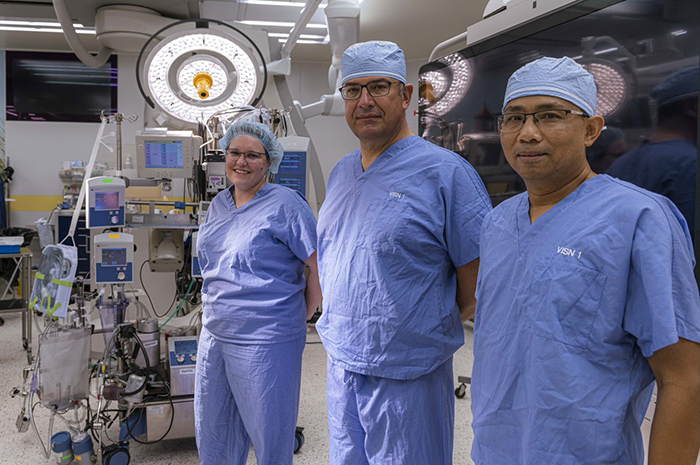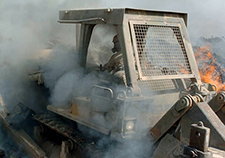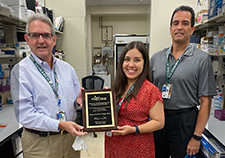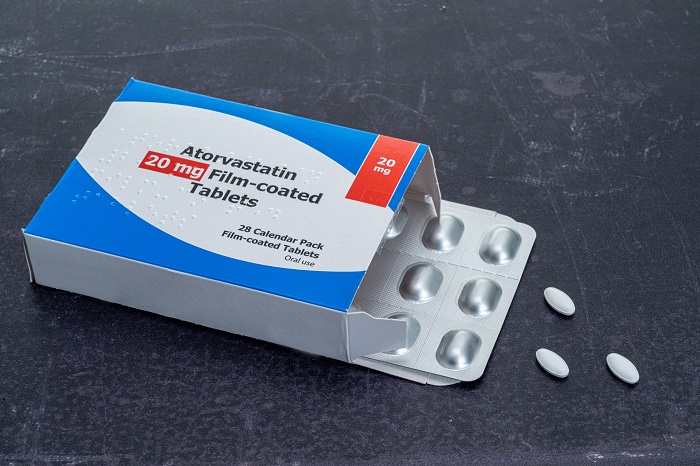Office of Research & Development |
 |


(From left) Drs. Lauren Kennedy-Metz and Marco Zenati and chief perfusionist Rithy Srey stand near a heart-lung machine in an operating room at the West Roxbury VA in Massachusetts. The team is studying how artificial intelligence can help perfusionists optimize use of the machines during cardiac surgery. (Photo by Deirdre Salvas)
November 18, 2021
By Tamar Nordenberg
For VA Research Communications
"The role of this model is to improve human performance during surgery, not take the place of the health professional."
VA experts in artificial intelligence are teaching computers to think like “perfusionists”—operating room staff who work heart-lung machines during surgery.
Doctors often stop a patient’s heart during a major cardiac surgery. In this situation, a perfusionist operates a heart-lung bypass machine. The machine supplies needed blood and oxygen to the patient, whose heart is on hiatus.

VA Study Documents Health Risks for Burn Pit Exposures

VA center training the next generation of researchers in blood clots and inflammation

AI to Maximize Treatment for Veterans with Head and Neck Cancer

Could cholesterol medicine reduce dementia risk in seniors?
In a paper titled “Using Machine Learning to Predict Perfusionists’ Critical Decision-Making During Cardiac Surgery,” researchers from the VA Boston Healthcare System, Harvard Medical School, Brigham and Women’s Hospital, and Georgia Tech University detail their progress toward a computer-based system to help perfusionists in the OR make critical decisions as they operate the bypass machine.
They presented the paper in September 2021 at a meeting of the Medical Imaging Computing and Computer Assisted Intervention Society.
Within VA and at other health facilities across the country, recent decades have seen sophisticated technologies enter the operating room. And growing numbers of medical specialists harmonize their roles in caring for patients. While these systems have improved patient health, they can also add to the pressure on OR staff.
In this pressure-cooker environment, the perfusionist must make quick and accurate decisions in managing the heart-lung (cardiopulmonary) bypass machine, says Dr. Marco A. Zenati, the study’s lead investigator. Zenati is chief of the Division of Cardiac Surgery at the VA Boston Healthcare System and a Harvard Medical School professor of surgery.
Even expert perfusionists can become overwhelmed, given the demands on them, says the physician-researcher, who leads the Medical Robotics and Computer-Assisted Surgery Lab at the Boston VA and Harvard. A computerized system to partner with perfusionists can improve patient safety, he says. This can potentially avoid adverse events such as kidney damage or a blood clot from heart-lung bypass.
Dr. Lauren R. Kennedy-Metz, a paper author and Harvard Medical School surgery instructor, likewise emphasizes the project’s importance. “The patient is at the mercy of the cardiopulmonary bypass machine during heart surgery, and a lot of pressure is on the perfusionist to make decisions in operating this really complex machine,” says Kennedy-Metz, a member of Zenati’s VA-Harvard lab. “The goal of this project is to apply a form of artificial intelligence called machine learning to make recommendations that perfusionists can rely on along with their own expertise.”
Veterans are among those who stand to benefit most. They may be especially susceptible, explains Kennedy-Metz, to adverse events during cardiac surgery, as they are often older and have conditions such as diabetes. Kennedy-Metz says she is proud of VA’s contribution to this study, including its role as the site for all data collection. She points to her VA site in Boston, where the study was based, as a prime example of leadership not only in this study, but in “a steady stream of highly impactful research.”
For perfusionists, one responsibility among many is to monitor the delivery of oxygen (DO2) while the patient is connected to the bypass machine. When DO2 falls below the threshold of 280 ml/min/m2, the patient is at risk for complications. The study focused on perfusionists’ responses to these dangerous dips in DO2. The goal is to enable computers to make decisions like master perfusionists—but without the strain that can undermine human judgment.
In the study, funded by the National Institutes of Health, researchers fed data to computers about a range of hypothetical situations in which DO2 sank during surgery, as well as perfusionists’ appropriate courses of action in response.
The computer was also given an algorithm—an elaborate set of mathematical rules based on advanced statistical concepts. This algorithm was based on the work of Georgia Tech’s Dr. Matthew Gombolay, a machine-learning expert and the paper’s senior author.
The objective was for the computers to “learn,” from a limited number of scenarios, to predict perfusionists’ decisions under different circumstances by teasing out complex patterns and applying them to new situations.
After creating the machine learning system, the researchers set about gauging the ability of the “trained” computers to predict perfusionists’ decisions.
For this step, researchers asked perfusionists what decisions they would make under various circumstances. They then queried computers about the same situations. Specifically, researchers asked two expert perfusionists to consider various theoretical situations they could face in the OR when oxygen delivery to a patient falls below the safe threshold. Circumstances included shifts in the patient’s health states, such as the levels of hematocrit (volume of red cells in the blood) and hemoglobin (substance in red blood cells that allows blood to distribute oxygen through the body). The two perfusionists chose a response to each scenario from among five option. The options included, for example, transfusing red blood cells or standing by, with or without alerting the surgeon to the concern.
A total of 154 decisions—77 from each of the two perfusionists—were compared against the computer’s recommendations based on the same fabricated scenarios. The research group’s machine learning model achieved 78% accuracy in this early phase of the study in predicting the actions the two perfusionists would take. This represents a “substantial” rate of accuracy, according to Dr. Roger D. Dias, the paper’s first author. Dias is a Harvard Medical School assistant professor for emergency medicine and head of the Human Factors in Cognitive Engineering Lab at the Brigham and Women’s Hospital.
Based on this successful early work, the research team is continuing their project under the NIH grant by equipping and testing computers’ machine-learning capabilities with enhanced data to better simulate a real-world operating room environment. Dias acknowledges that the real-life environment is “much more dynamic” than reflected in the research scenarios so far.
In the next stage of their project, the investigators will record real-life scenarios in the OR, including heart surgery patients’ actual health vital signs while they are connected to the bypass machine. By also measuring perfusionists’ heart rate, this next research phase could identify times when perfusionists feel overloaded with information and stressed. During these times, the health professionals might be especially helped by the computer model’s recommendation.
“By providing real data from the surgical environment instead of saying to perfusionists, ‘Imagine yourself in this scenario,’ this next step will more realistically reflect decision-making in the stressful environment of the operating room,” Kennedy-Metz says.
Regardless of how refined the computer model becomes, Dias emphasizes that the perfusionists will continue in their primary decision-making role in the OR.
“The role of this model is to improve human performance during surgery, not take the place of the health professional,” he says. “It is the humans who will use their judgment in each situation to decide whether or not to follow the machine-learning recommendations.”
For now, the research team is working to hone the capabilities of machine learning to support perfusionists. The team is optimistic that similar decision-support tools may ultimately support other OR professionals as well, such as surgeons, anesthesiologists, and nurses. They also foresee the technology eventually playing a role in emergency rooms and ICUs.
VA Research Currents archives || Sign up for VA Research updates